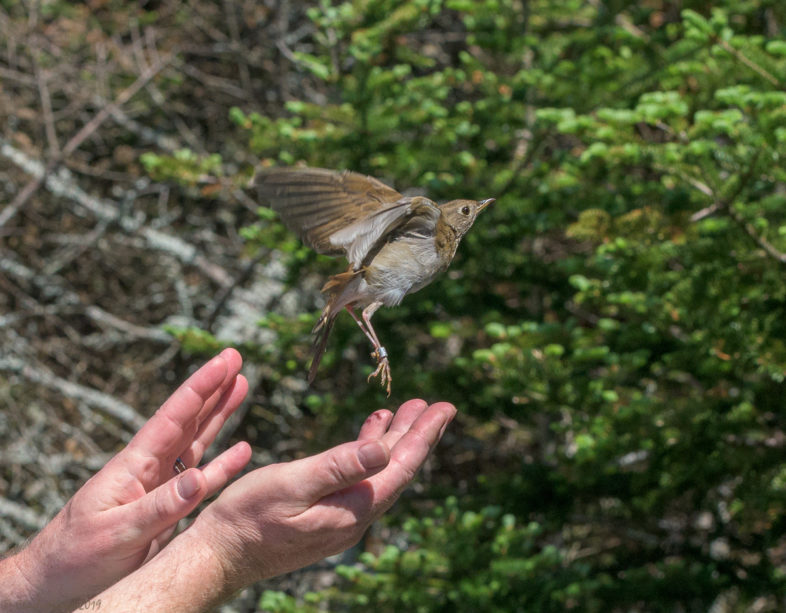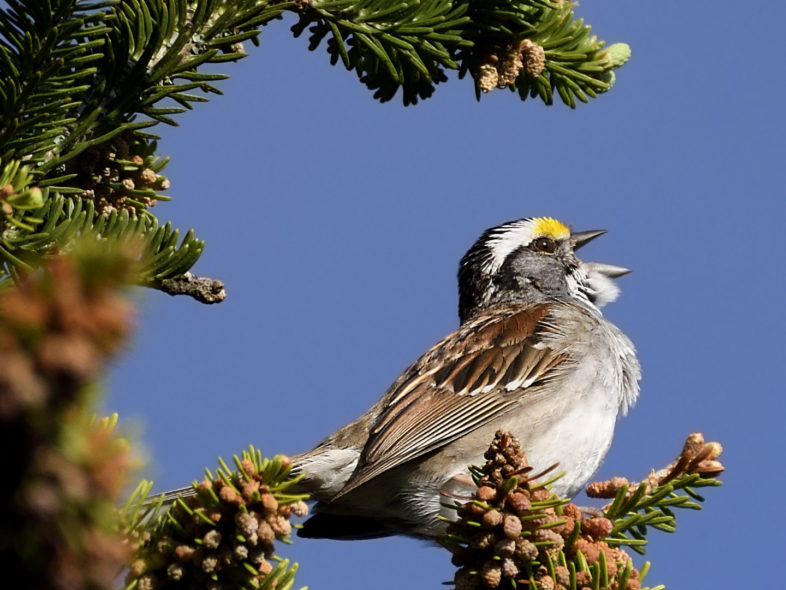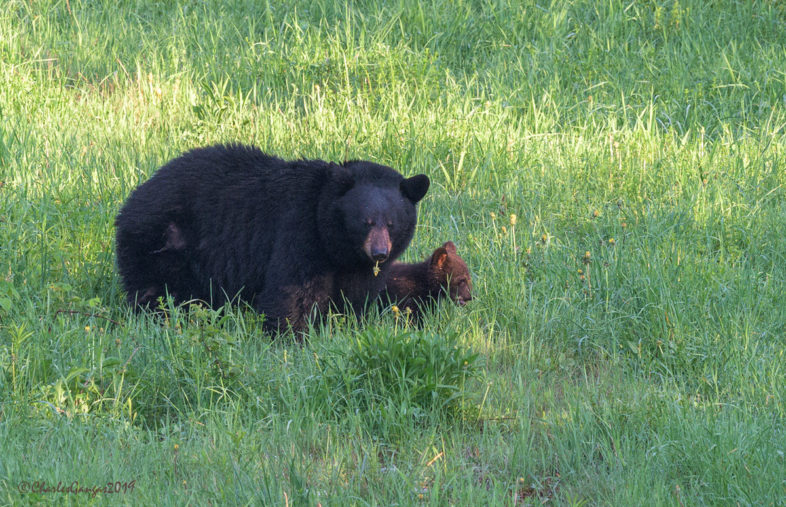
A banded Bicknell’s Thrush beats a hasty retreat to the balsam firs after being released. Mt. Mansfield, 27 June 2019. © Charles Gangas
Four weeks into VCE’s 28th field season of studying the breeding birds on Mt. Mansfield’s ridgeline, our overriding question is: where are they?? Echoing a theme—more a lament—from Adirondack montane forests to Green Mountain old-growth hardwood stands to backyard woodlots across the Upper Valley, many of us are perplexed about the current scarcity of forest birds. Nowhere has this been more apparent (to me, at least) than on Mansfield, where our most recent banding session on 25-26 June was the slowest yet of 2019.
Running 23 mist nets under near-ideal weather conditions (warm, calm, light cloud cover) on Tuesday evening and Wednesday morning, we captured a grand total of 22 birds. Only six of these were previously unbanded, the rest (except one return Bicknell’s Thrush) within-season recaptures. As during the previous three weeks, vocal activity was sparse, even at dawn and dusk, mirroring the lack of action in our mist nets. We have so far captured 125 birds this year, a mere 43% of the 290 individuals netted by this same date a year ago. Comparing 3 common species between the two years gives some perspective: Bicknell’s Thrush (40 in 2018:24 in 2019), Swainson’s Thrush (11:3), Blackpoll Warbler (30:18).

One of the few singing White-throated Sparrows within earshot of the VCE banding station on Mt. Mansfield, 27 June 2019. © Micheal Sargent
There were no surprises in this week’s tally:
Winter Wren — 2: new male and new female with regressing brood patch
Bicknell’s Thrush — 9 (6 males, 3 females): 7 within-season recaptures, 1 new ASY male, 1 return female from 2018; all females with fully-developed incubation/brood patches
Dark-eyed Junco (Slate-colored) — 1 within-season recapture female
White-throated Sparrow — 1 new male
Blackpoll Warbler — 6 within-season recaptures; 2 females with fully-developed incubation/brood patch
Black-throated Blue Warbler — 1 female with regressing brood patch
Yellow-rumped Warbler (Myrtle) — 2 males: new SY and within-season recapture
So, what is going on? Have regional forest bird populations, or at least those breeding at high elevations, nosedived within the past year? Did the rough weather of spring take a toll on survivorship of early-returning migrants? Did some simply move to more hospitable sites, perhaps at lower elevations? Are reduced bird populations reflecting widely-noted insect declines? Mosquitoes and black flies seem abundant enough, but butterflies and moths (which produce the soft-bodied larvae that many songbirds feed their young) seem low. Or, are birds actually present but just laying low, not singing and moving much, thus escaping our detection? There is no sure way to determine any of this now. Many factors combine to cause short-term fluctuations in bird populations, and it is the longer-term situation that warrants our attention. This speaks to the importance of sustained monitoring, whether through Mountain Birdwatch, the USFWS Breeding Bird Survey, the Vermont Forest Bird Monitoring Project, or our nearly 30 years of netting on Mansfield. With another five weeks to go in our field season, we should have additional insights—and perhaps a more hopeful outlook—during the weeks ahead.

It’s not just about the birds—a female black bear and her cub provided a welcome distraction as they foraged on a ski slope just below the Octagon on Mt. Mansfield, 27 June 2019. © Charles Gangas.


Wonderful photos, per usual. Thanks for them and for the reports.
I have observed the same thing here, Island Park Idaho. Could go into some detail.
I have notice the same thing here on Peacham Pond. Usually at 5 am this time of year you can’t sleep because of all the birds chirping. Not so this year.l Been wondering what has been going on
People for the most part stopped feeding the birds, thanks to dept of fish and game dept. threatening to fine people who feed them. I live in bethel. Missing the birds.